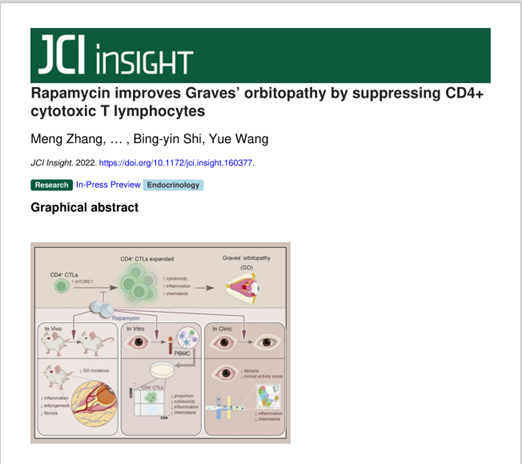Graves' ophthalmopathy (GO) is an autoimmune-mediated orbital inflammatory disease. Elucidating the pathogenesis of GO and identifying specific therapeutic targets have always been hotspots and difficult topics in this field. To resolve these problems, the team led by Professor Shi Bingyin and PhD Wang Yue from Department of Endocrinology of the First Affiliated Hospital of Xi 'an Jiaotong University (XJTU) have been dedicated to from-bench-to-bedside research on the pathogenesis and therapeutic targets of GO for nearly 10 years. In previous research, the team has identified a group of CD4+ cytotoxic T lymphocytes (CTLs) characterized by inflammation and chemotaxis in the peripheral blood of GO patients by single-cell RNA sequencing, which is a potential novel therapeutic target for GO. Based upon this target, the team chose rapamycin, an immunosuppressant, as a potential treatment regimen for GO. Through animal modelin vivo,in vitroexperiment and clinical intervention, the team confirmed that rapamycin can not only reduce the incidence of GO mice from 87.5% to 37.5% by targeting CD4+CTLs, but also effectively alleviate diplopia and clinical activity score in steroid-refractory GO patients. Therefore, rapamycin is a promising treatment for GO.

These findings were recently published as an article entitled Rapamycin improves Graves’ orbitopathy by suppressing CD4+ cytotoxic T lymphocytes in The Journal of Clinical Investigation (JCI) Insight (IF=9.5), an internationally renowned academic journal. PhD Zhang Meng, Professor Kelvin K. L. Chong from The Chinese University of Hong Kong and doctoral student Chen Ziyi are the co-first authors. Professor George J. Kahaly from Gutenberg University Medical Center in Germany, Professor Shi Bingyin and PhD Wang Yue are the co-corresponding authors of this article. In 2020, the team has established a prediction model for GO in a cohort study of Graves’ hyperthyroidism by T cell receptor (TCR) sequencing (Clinical and translational medicine, IF=8.5). In 2021, they employed single-cell RNA sequencing to identify a group of GO-specific CD4+ CTLs (Cellular & Molecular Immunology, IF=22). In 2021, the team also established and systematically evaluated a GO mouse model (Thyroid, IF=6.5). Hence, this is another groundbreaking achievement in the field of from-bench-to-bedside research of GO.
Based on this new advancement in the treatment of GO, the team has launched a nationwide multi-center clinical study regarding the treatment of GO with rapamycin. This project was led by our hospital, and 8 hospitals including Beijing Tongren Hospital affiliated to Capital Medical University, Shunde Hospital of Southern Medical University, Tangdu Hospital of Air Force Medical University and other hospitals participated in this project. These research results are expected tobe truly translated into clinical application very soon.
Article link: https://insight.jci.org/articles/view/160377